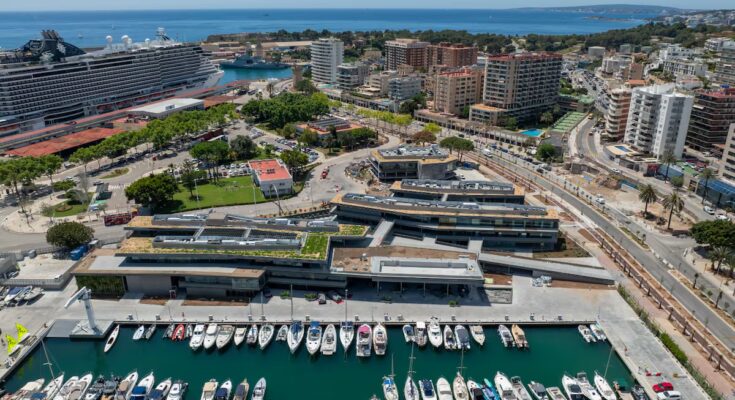The Mallorca Sea Club, a private institution founded in 1972 to attract large ships to the bay of Palma, is preparing to change its skin, going from being a private and exclusive club of 321 members to a structure that will be connected via a walkway to the cruise terminal and the city. The walkway was inaugurated last Saturday and the well being and spa, available only to members, will do so from December 1st. From the beginning of January it will also have four new buildings, two of which will have catering and leisure areas for residents of Mallorca and travelers arriving via large international companies such as MSC or Costa Cruises. “We managed to combine the exclusivity of a space reserved for members with openness to the city,” underlines José Luis Arrom, general director of the Club de Mar de Mallorca, in an interview with Five days.
With a total investment of 95 million euros, the largest investment made in a pleasure port in Spain, financed entirely by the members, and work lasting five years, the new Sea Club will have 543 berths, of which over 70 for boats between 40 and 170 meters in length. “We will be able to accommodate up to five gigayachts between 136 and 170 meters in length at the same time,” acknowledges Arrom. In recent summers, the megayachts of Jeff Bezos, founder of Amazon, and Mark Zuckerberg, founder of Facebook, have docked on its pontoons, having had a great media impact. “Marinas, like ours, were developed for boats from 50 years ago. Now they are bigger and wider to improve the comfort of their owners. So what we have done is reduce the number of berths to have more width and length and at the same time provide them with many more services,” Arrom points out.
An expense of 300 million euros per year
The bulk of the investment, undertaken only once the renewal of the concession was guaranteed for another 25 years thanks to the “strategic nature of the investment”, which begins to count in 2019, was absorbed by the four new buildings. The largest, called Tramontana, will have three floors and will be reserved for Club members and staff. Two other buildings (Levante and Poniente) will host the commercial area open to all citizens. “It will have 33 stores, which are 95% contracted right now.” There will be four restaurants, a supermarket managed by El Corte Inglés and among the shops there will be jewelery shops, women’s fashion or swimwear boutiques. For its part, the fourth building, called Migjon, will be an events center, combining business meetings with a recreational area for members and residents.
The 321 partners who financed the multimillion-dollar investment, which also had the support of Banco Santander, expect a rapid return from the study on the economic impact of the new Club de Mar de Mallorca, which foresees an annual income of 300 million euros and the generation of 5,000 direct, indirect and induced jobs. “Superyachts alone will invest 145 million euros in maintenance and services.” Arrom points out that another line that will serve to increase revenue will be the holding of sporting competitions and boating-related events. Thus, the general director of the Sea Club underlines that this year was the first in which he hosted the new exhibition area of the Superyacht New Build Hub (one of the three of the Palma International Boat Show), intended for the participation of boats (10 sailing boats of over 40 meters in length did so) of great length built by shipyards that produce to order.


